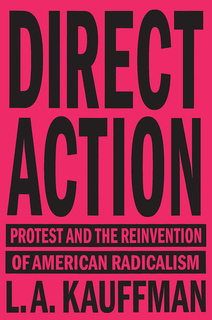By L.A. Kauffman
Verso, 2017, 256 pages
Trade paperback: $17.95
February 21, 2017
ISBN: 9781784784096

Not that "Direct Action" is new, even in the normally non-radical United States. Taking control of a factory, taking control of streets, occupying a university or some other venue, has been familiar for at least a century, arguably beginning when the Industrial Workers of the World first "sat down" instead of leaving the factory to picket its entrances. (Women's actions in the urban Rent Strikes of the early 1930s would be another great example). Spartacus may have been one of the earliest radical occupiers, of territory that is. But let's stick with the past century, for convenience. The general problem of strikes is that the strikers are on the outside, as are demonstrators in most instances, people (like me) listening to talks and then marching. The alternative, if it works, is to be in the inside, holding on, at least for long enough to make a point.
Kauffman begins with an apparent success that was more of a failure: an occupation of DC in 1971 that apparently took the authorities by surprise, but more likely tested their ability, at that stressful historical moment, to let the demonstrators have their moment, never actually threatening the functions of government, including the Vietnam War. To have confronted them directly, violently, would have raised problems. At the end of the day, the demonstrators went home. And yet, the presence of multiple constituencies-gay pride featured for the first time in a major mobilization-had to be counted as a plus. According to Kauffman's account, something had changed.
She is on stronger ground in depictions and analyses of subsequent demonstrations, and there is a reason for that: she was there, in much of the action of the rest of the book. This is what makes Direct Action an important, even essential text. She offers an inside look at mobilizations, what was wrong with them and what was right with them, as the decades passed and "we lost" time after time, but also, at least sometimes, made our efforts felt.
She suggests that the mobilizations of the 1960s, massive in character and often adaptive in method, made a difference in the way activists looked upon organizing efforts. Her first example is a remarkable one, because the Mayday Tribe that sought to occupy DC in 1971 had the oddest origins, described by an organizer from the War Resisters League as "merging radical politics, Gandhian nonviolence, serious rock and roll, lots of drugs." A vision of decentralized disruption followed years of huge demonstrations that seemed to have no effect on the warmakers, and sometimes literally explosive projects by Weatherman and others that backfired politically.
Whatever the results otherwise, the DC action deeply involved Gay Mayday and in that sense advanced even as the authorities swept up demonstrators by the thousands. Widespread support for the jailed demonstrators by the local black community was another happy element. But in a larger sense, the era of mass demonstrations had ended in a sense of loss.
Kauffman makes the important point that action shifted locally, in many different venues. I think she misses the role of left-leaning electoral politics, doubtless because this is not the focus of the book. In my experience, electoral victories reinforced a lagging sense of empowerment and produced much for demonstrators, including a down-toning of police Red Squad action. Never mind: she is on to the Clamshell Alliance against the Seybrook nuclear plant, a too-forgotten Women's Pentagon Action in 1981, a Free South Africa movement with its Campaign Against Apartheid on campuses (a preparation, so to speak, for support of Palestinian freedom, in later decades) and a sort of return to old style mobilizations with the 1982-8e marches on DC, labor support for PATCO strikers and the MLK anniversary. These last, to speak from personal experience, were epiphany-like moments of unity.
Kauffman was deeply involved in the Central America support movement of the 1980s, which (although she does not say it) may be regarded as the last great effort deeply engaging the veterans of the 1930s-40s, i.e., aging Reds and ex-Communists. They had vast talents as organizers and among those talents an impressive ability to keep quiet about political differences within the Left. The oldtimers also helped lead the effort to break through the Cold War lock on the AFL-CIO (in this case, AFL-CIA) by its corrupt, corporate-style leaders. It is intriguing that the Divestment projects, mainly on campuses, set CIA crimes past and present on trial, and in doing so, recalled SDS and the 1960s antiwar movement including the campus occupations.
Kauffman also makes the point that the direct action ecological movement of the 1970s-80s point in the same direction, against the alliance of government, business and labor bureaucracy armed with hypocritical participation of think-tank campus "experts" on depopulating third world zones for mineral extraction and mass scale agribiz. Greenpeace organized to save the whales by going after the ships, and Earth First! activists sat in trees among other actions. ACT UP showed a willing to go further, in part because it had massed potential constituencies in New York and LA among other places. The cultural styles of ACT UP brought back the panache of the 1960s-70s, including the wonderfully humorous assaults of the early Women's Liberation Movement on propriety.
"Waves of activism always recede," Kauffman notes (p.132) and the movements of the 1980s faded by the early 1990s, leaving behind memories to be recuperated by successors. Among the most important successors was surely the response to what should be called Bill Clinton's incarceration offensive and the Rudolph Giuliani version, both of these actually supported by a host of erstwhile liberals swiftly becoming neoliberals. No doubt the 1988 Jesse Jackson campaign (crushed in much the same way as Bernie Sanders, eighteen years later) was a half way house between Black Power and the Black Radical Congress, marked less by direct action than an intermittent mobilization. Direct Action returns with a bang: the 1999 Seattle "Teamsters and Turtles" anti-globalization protests.
Kauffman plunges on to our present century with events that will seem closer to today's younger readers, the protest at the 2004 Republican convention in New York, the Dream Defenders' marches for immigrant rights, Occupy and Black Lives Matter. There is no proper way to end such a narrative, but the highway blockades after police murders of African Americans seems as good as any.
Kauffman does not and could not claim to be comprehensive, and it would be unjust to point to this, that or the other direct action left out here (the seizure of Alcatraz? The Wisconsin Uprising? We could go on.) because this is not intended to be an encyclopedia. I find some political pals of the 1960s-present often left out because of our work alongside a fading but sometimes still lively labor movement, and other pals left out because they staged demonstrations to create urban funds for murals, or provided signs and paper mache creatures for the direct actions and so on. At the end of this particular day, Kauffman comes out a shrewd and humane savant, an extreme egalitarian along any demographic lines we might choose, and for that reason a writer to be taken seriously. Read the book before setting out to the next demonstration or planning meeting. You won't be sorry.##
[Paul Buhle usually ended up the Emcee, introducing the really important people. He is the author or editor of 35 volumes including histories of radicalism in the United States and the Caribbean, studies of popular culture, and a series of nonfiction comic art volumes. He is the authorized biographer of C. L. R. James. He co-edited the outsize oral history tome Tender Comrades, with Patrick McGilligan, and with co-author Dave Wagner, A Very Dangerous Citizen, the biography of Abraham Lincoln Polonsky. With Mari Jo Buhle and Dan Georgakas, he co-edited the Encyclopedia of the American Left.]


Spread the word